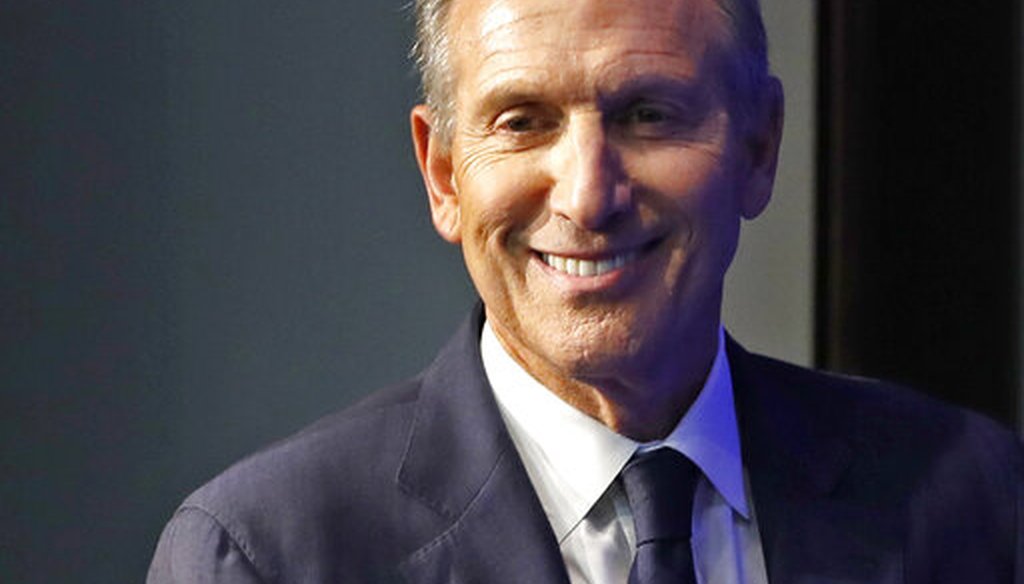



Former Starbucks CEO and Chairman Howard Schultz smiles as he walks on stage at the kickoff event for his book promotion tour Monday, Jan. 28, 2019, in New York. Schultz has teased the prospect of a 2020 presidential bid. (AP Photo/Kathy Willens)
Former Starbucks chief executive Howard Schultz told CBS’ "60 Minutes" that he’s "seriously considering" a 2020 run for the White House.
The self-described lifelong Democrat, who developed a reputation as a socially conscious leader while overseeing the coffee mega-company for 32 years, told CBS correspondent Scott Pelley on Jan. 27 that he would run as a "centrist independent outside of the two-party system."
At one point in the interview, the billionaire reflected on the financial stresses that he says motivate him to run for the nation's top office. "When I read statistics that says that over 40 percent of the American people don't have $400 in the bank and only a crisis away from bankruptcy…this is what I think about."
The claim stood out as a stark description of everyday life in America, so we wanted to know if it was accurate. Our reporting found that Schultz’s claim is on the right track, although he overstated it a bit.
This is not the first time we have checked a claim about American finances from Schultz’s shop. In 2015, Starbucks published an eight-page insert in USA Today explaining why it wanted to start a national conversation about race. It included this statistic: "White people control almost 90 percent of the nation's wealth." We rated it True. It matched the latest net worth figures from the Federal Reserve System at the time.
Schultz’s 40 percent statement reminded us of something former Washington Post reporter Hunter Schwarz said in 2015 before joining CNN. Schwarz said that 47 percent of Americans "can’t pay for an unexpected $400 expense through savings or credit cards, without selling something or borrowing money." PunditFact rated that claim True.
As our colleagues reported, Schwarz’s statement was based on results of a nationally representative sample of American adults who completed an online survey in October 2014 by the Federal Reserve Board. When asked how they would pay for an emergency expense of $400, 53 percent said they would be able to pay essentially immediately, while 47 percent said they could not.
But that’s based on a survey taken more than four years before Schultz made his statement, and the reporter’s statement was somewhat more precise.
So, let’s dig in.
We didn’t hear back from Schultz’s office about what he used as the basis for his statement. But the Fed has done its survey, in what is known as the "Report on the Economic Well-Being of U.S. Households," each year since 2013. And the most recent results, released in May 2018, got coverage from NPR, CNBC, Forbes, Fox Business and other national media.
The new survey, conducted in November and December 2017 with more than 12,000 respondents, found that:
"Four in 10 adults, if faced with an unexpected expense of $400, would either not be able to cover it or would cover it by selling something or borrowing money."
So, that isn’t direct evidence that 40 percent of Americans don’t have at least $400 in a bank account.
But, based on the survey, the 40 percent didn’t have that much in their checking or savings; or, they said they would resort instead to borrowing or selling something to cover the expense.
The Fed noted that 40 percent was an improvement from half of adults in 2013 being ill-prepared for such an expense.
Two points worth noting before we close:
• An April 2018 report by the Global Financial Literacy Excellence Center at George Washington University found that 36 percent of the population couldn’t come up with $2,000 within the next month to cover an emergency expense — a measure the report said is similar to being able to come up with $400 immediately.
• Given the drop in unemployment and generally good economy, the figure might now be lower than the 40 percent cited in the Fed survey, Marquette University emeritus economics professor Abdur Chowdhury told us.
Schultz said "over 40 percent of the American people don't have $400 in the bank."
Based on the latest survey from the Federal Reserve Board, Schultz is essentially on track: 40 percent of Americans said that, if faced with an emergency expense of $400, they would not be able to cover it, or would have to borrow or sell something in order to cover it.
We rate Schultz's statement Mostly True.
CBS, Howard Schultz interview (6:50), Jan. 27, 2018
PunditFact, "47% say they lack ready cash to pay a surprise $400 bill," June 9, 2015
Federal Reserve Board, "Report on the Economic Well-Being of U.S. Households in 2017," May 2018
Federal Reserve Board, Appendix B, May 2018
Global Financial Literacy Excellence Center, "Financial Fragility in the US: Evidence and Implications," April 2018
Email, George Washington University economics and accountancy professor Annamaria Lusardi, editor of the book Overcoming the Saving Slump, Jan. 28, 2019
Email, University of California, Berkeley, sociology professor Daniel Schneider, whose research specialties include economic instability, Jan. 28, 2019
Email, American Enterprise Institute economic policy resident scholar Aparna Mathur, Jan. 28, 2019
Email, Harvard University senior lecturer on economics and Cato Institute director of economic studies Jeffrey Miron, Jan. 28, 2019
Email, Marquette University emeritus economics professor Abdur Chowdhury, Jan. 29, 2019
In a world of wild talk and fake news, help us stand up for the facts.
